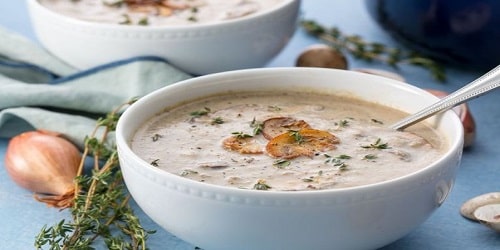Difference Between Cream And Puree
Although sometimes when cooking we can confuse some culinary terms that seem similar, the truth is that in the case of cream and puree the differences are notable in terms of their preparation, texture, and culinary uses.
Cream and puree are two of the simplest ways to prepare foods and especially vegetables, helping us introduce more vegetables into the diet. Although both preparations may seem similar, they differ in aspects such as their preparation, their consistency, and their different culinary uses. Below, we explain the main differences between both types of preparation.
What is a cream
Coming from the French “crème” which means “cream”, cream is a culinary preparation with a creamy consistency that is usually prepared with vegetables, although sometimes also with meat or fish, and the right amount of liquid to obtain a kind of thick soup made with those crushed foods. Originally it was prepared from a roux (a mixture of flour and a fatty element) and with some dairy such as milk, cream or cheese, but nowadays they are usually prepared simply with vegetables, meat, or fish.
What is a puree
From the French ” purée “, which means “purified” or “refined”, purée is another preparation that consists of cooking food in the right amount of water or broth, so that by draining, crushing, and blending them we obtain a texture preparation dense and consistent. The puree can be cooked using any type of vegetable, vegetable, or legume, and although it is not the most common, also with meat, fish, and even fruits, legumes, or cereals.
How is a cream different from a puree?
The basic differences between both preparations are the way they are made, their consistency and texture, and also their different culinary uses. Creams are thinner and lighter, while purees are thicker and creamier.
Consistency and texture
Cream generally has a lighter, more liquid consistency than purees and has a velvety texture on the palate. A cream can be served both cold and hot, as well as accompanied by different garnishes to complete it such as chopped herbs, pieces of vegetables, grated cheese, and croutons… The most important thing to achieve the ideal texture and consistency, in addition to cooking the food, is the crushed one.
The puree, for its part, has a much denser consistency than the cream, as well as a more or less creamy texture depending on its production process. As a general rule, and unlike cream, puree is usually served hot.
Culinary uses
Another difference between cream and puree is their culinary uses. The cream is usually served as a starter or main course if we are referring to salty preparations such as a cream of mushroom soup, the traditional vichyssoise or a seafood cream. If it were a sweet preparation, we will normally use it to prepare other preparations. For example, a chocolate cream for cake fillings or as a decoration for a sponge cake, or a creme anglaise as a base for a puff pastry cake with fresh fruit.
If we refer to the puree, and based on a salty puree, it is generally served as a garnish to accompany other dishes, although it could also be served as a main dish. Likewise, mashed potatoes, for example, can be used to prepare recipes as tasty as Parmentier hashish. If, on the other hand, we prepare a puree with fruits such as banana, strawberry, or apple, we will use it as a filling for desserts such as cakes, puff pastries, sponge cakes, or muffins, as a base for fruit smoothies or in desserts such as mousse, ice cream…
Preparation
Purees, for their part, can be made with a variety of ingredients, including vegetables, legumes, cereals, fruits, meats or fish. In general, less liquid is used to prepare purees than for creams, so the result is a thicker, pastier texture.
To prepare a cream, according to its ingredients, first we will have to wash, peel, and chop the vegetables, as well as clean the meat or fish. After having cut the food into pieces, we will proceed to fry them for a few minutes with a splash of olive oil, and then cook them using water or vegetable, poultry, meat, fish, or seafood broth. Depending on the thickness of the cream, we will cover it with the liquid of our choice to cook the ingredients over medium heat for 20 or 30 minutes. If the cream contains meat, fish, or seafood among its ingredients, it is important to add them boneless and boneless. After the cooking time has passed, we will blend with a blender or food processor until we obtain a soft, smooth, and homogeneous cream.
If we are going to make a puree, we will peel the vegetable ingredients, and without chopping them we will cook them using only the right amount of water in this case to cook them together with a pinch of salt for about 30 minutes. Before finishing cooking, we recommend checking that the ingredients are cooked by piercing them with a knife. For the puree to be very creamy, it is essential to carry out the following steps with hot foods. With the help of a fork or a potato masher, we will mash the ingredients until they are completely dissolved. We will add a few cubes of butter, and mix with the help of a silicone spatula until the butter melts. To finish, we will add a little hot milk to taste while stirring until the puree has the desired texture. If we want a finer result, we will need to pass the puree through a food mill to achieve an even creamier texture.
